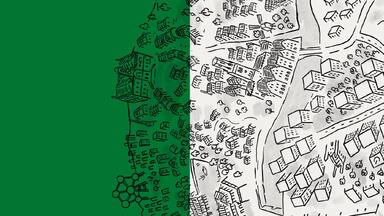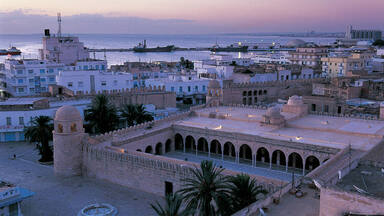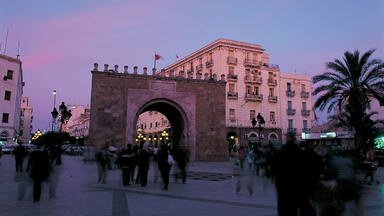Challenges and opportunities of historic urban centres: case study of the Medina of Tunis (Tunisia)
The Medina of Tunis is a complex, living site at the centre of a bustling metropolis. In order to protect this historic site and promote its sustainable development, a number of actions are addressing the preservation and promotion of its cultural heritage.
About the city of Tunis
Tunis is the capital city of Tunisia. It is the fourth-largest city in the Maghreb region, with a large metropolitan with approximately 2,700,000 inhabitants. The Medina of Tunis was inscribed on the World Heritage List in 1979 under criteria (ii), (iii) and (v).
Located in a fertile plain region of north-eastern Tunisia, and a few kilometres from the sea, the Medina of Tunis is one of the first Arabo-Muslim towns of the Maghreb (698 A.D.). Capital of several universally influential dynasties, it represents a human settlement that bears witness to the interaction between architecture, urbanism and the effects of socio-cultural and economic changes of earlier cultures. Under the Almohads and the Hafsids, from the 12th to the 16th century, Tunis was considered one of the greatest and wealthiest cities in the Arab world. Between the 16th and 19th centuries, new powers endowed the city with numerous palaces and residences, great mosques, zaouias and madrasas.
Challenges and opportunities of historic urban centres: case study of the Medina of Tunis
Presentation of the case study during the "Living with Heritage" webinar on 17 May 2021
The World Heritage site of the Medina of Tunis is a complex urban ensemble, covering approximately 295 ha. Its management framework includes national and local institutions, as well as different levels of statutory protection. As the centre of a bustling metropolis, the Medina of Tunis is developing a number of actions to strengthen its role within the city through the preservation and promotion of its cultural heritage.
Author: Montassar JMOUR © Institut National du Patrimoine
Author: Montassar JMOUR © Institut National du Patrimoine
Context and management framework
The World Heritage site is composed of the central 8th century medina and 13th century suburbs to the North and South. There are some 700 historic monuments, distributed in 7 areas. The institutional framework for the management and conservation of the site includes a number of national and local institutions, such as:
- Tunisian Ministries of Culture, Equipment, and Tourism and Handcrafts.
- Cultural institutions associated with ministries, such as the National Heritage Institute, the Agency for the Promotion of Heritage and Culture, the Agency for Urban Rehabilitation and Renewal, and the National Tourism Office.
- Municipalities, with their regional administrations.
The site is protected through a legal framework including Law 35-1994 for the protection of archaeological, historical and traditional artistic heritage, the Urban Plan of the Medina of Tunis (plan d’aménagement urbain), the inscription on the World Heritage list and buffer zone.
The Medina of Tunis is facing a number of challenges. These include issues related to outdated infrastructures, the precarious living conditions of local residents, abandonment of ancestral dwellings, heritage degradation, disappearance of traditional economic activities, and absence of integrated vision for the management and protection of the medina.
Author: Montassar JMOUR © Institut National du Patrimoine
Author: Montassar JMOUR © Institut National du Patrimoine
Heritage-based interventions in the Medina
In order to face the upcoming challenges, the Medina or Tunis has developed a number of objectives for the future development of the property, including ensuring the integration of the Medina within the larger metropolis, conserving its identity and unity, and promoting a global approach which balances cultural and heritage values and socio-economic needs. At the same time, it is essential to promote the engagement of local communities and stakeholders in the management and conservation of the property.
To reach the goals above, a number of short-, medium- and long-term projects are being developed, including:
- Urgent interventions, such as the consolidation of historic buildings in a poor state of conservation, avoiding further deterioration.
- Development of an inventory of built heritage and a diagnostic assessment;
- Creation of touristic routes within the Medina;
- Restauration of monumental heritage, such as the Mausoleum Torbet El Bey and the gate of Beb Ejedid;
- Elaboration of a Management and Promotion plan.
- Promotion of new technologies, such as the virtual platform medina stories.
Author: Montassar JMOUR © Institut National du Patrimoine
The Medina of Tunis is a complex site, a living World Heritage site at the heart of a bustling metropolis. Its outstanding cultural heritage and location creates great possibilities to promote sustainable culture-based development that sustains local livelihoods. However, turning this possibility into a reality requires the collaboration of a large number of partners and institutions and the implementation of a wide programme of actions targeting both tangible and intangible heritage, in line with the strategic vision of the site and conservation and management goals. The ultimate goal of the site management authority is to ensure the sustainable safeguarding of living heritage in a way that enables its continuous evolution and adaptation. Additionally, the site management authority aims to enhance the sensitive dimension of the territory, to be as close as possible to its material and immaterial realities, exploring the interactions and sensitive experiences between residents and their territory.
Source: Mr Montassar Jmour, site manager of the Medina of Tunis, 2021.
Contribution towards the implementation of the 2011 Recommendation on the Historic Urban Landscape
The initiative aims to contribute to the implementation of the Historic Urban Landscape approach by promoting a landscape approach to urban heritage conservation, including both its tangible and intangible components; and the integration of heritage conservation and urban planning tools.
Historic Urban Landscape Tools
Contribution towards Sustainable Development
If fully implemented in accordance with the described plans, the initiative could contribute towards Sustainable Development and the Sustainable Development Goals.

Goal 8. Promote sustained, inclusive and sustainable economic growth, full and productive employment and decent work for all.
- Target 8.9: the initiative aims to promote sustainable tourism that creates jobs and promotes local culture and products.

Goal 11. Make cities and human settlements inclusive, safe, resilient and sustainable.
- Target 11.3: the initiative aims to enhance integrated and sustainable urbanisation.
- Target 11.4: the initiative aims to strengthen efforts to protect and safeguard the world’s cultural heritage.
Note: the described potential impacts of the projects are only indicative and based on submitted and available information. UNESCO does not endorse the specific initiatives nor ratifies their positive impact.
To learn more
- Watch the presentation by site manager Mr Montassar Jmour during the UNESCO-UfM online conference “Living with World Heritage: Adaptive Reuse and Regeneration in the Euro-Mediterranean region”.
- Visit the virtual platform medina stories
- Read about the Medina of Tunis on the website of the Tunisian National Heritage Institute (in French).
- Read about the restoration project of the Archaeological Gate of "Beb Bhar" (in French).
Contact
Mr Montassar Jmour, architect-in-chief, director of the conservation of the Medina of Tunis, National Heritage Institute, Tunis.
- Tél /Fax: (+216) 71 321 452
- Address: 04, Place du château, Beb Mnara, Tunis
- Website: www.inp.rnrt.tn
Cover image credits: Sidi Ben Arous St. Author: Montassar JMOUR © Institut National du Patrimoine. Image credits and acknowledgements: Conservation de la Médina de Tunis (CMT) / Thanks to all the team of the Conservation de la Médina de Tunis.
Note: The cases shared in this platform address heritage protection practices in World Heritage sites and beyond. Items being showcased in this website do not entail any type of recognition or inclusion in the World Heritage list or any of its thematic programmes. The practices shared are not assessed in any way by the World Heritage Centre or presented here as model practices nor do they represent complete solutions to heritage management problems. The views expressed by experts and site managers are their own and do not necessarily reflect the views of the World Heritage Centre. The practices and views shared here are included as a way to provide insights and expand the dialogue on heritage conservation with a view to further urban heritage management practice in general.



 8 Decent Work and Economic Growth
8 Decent Work and Economic Growth
 11 Sustainable Cities and Communities
11 Sustainable Cities and Communities